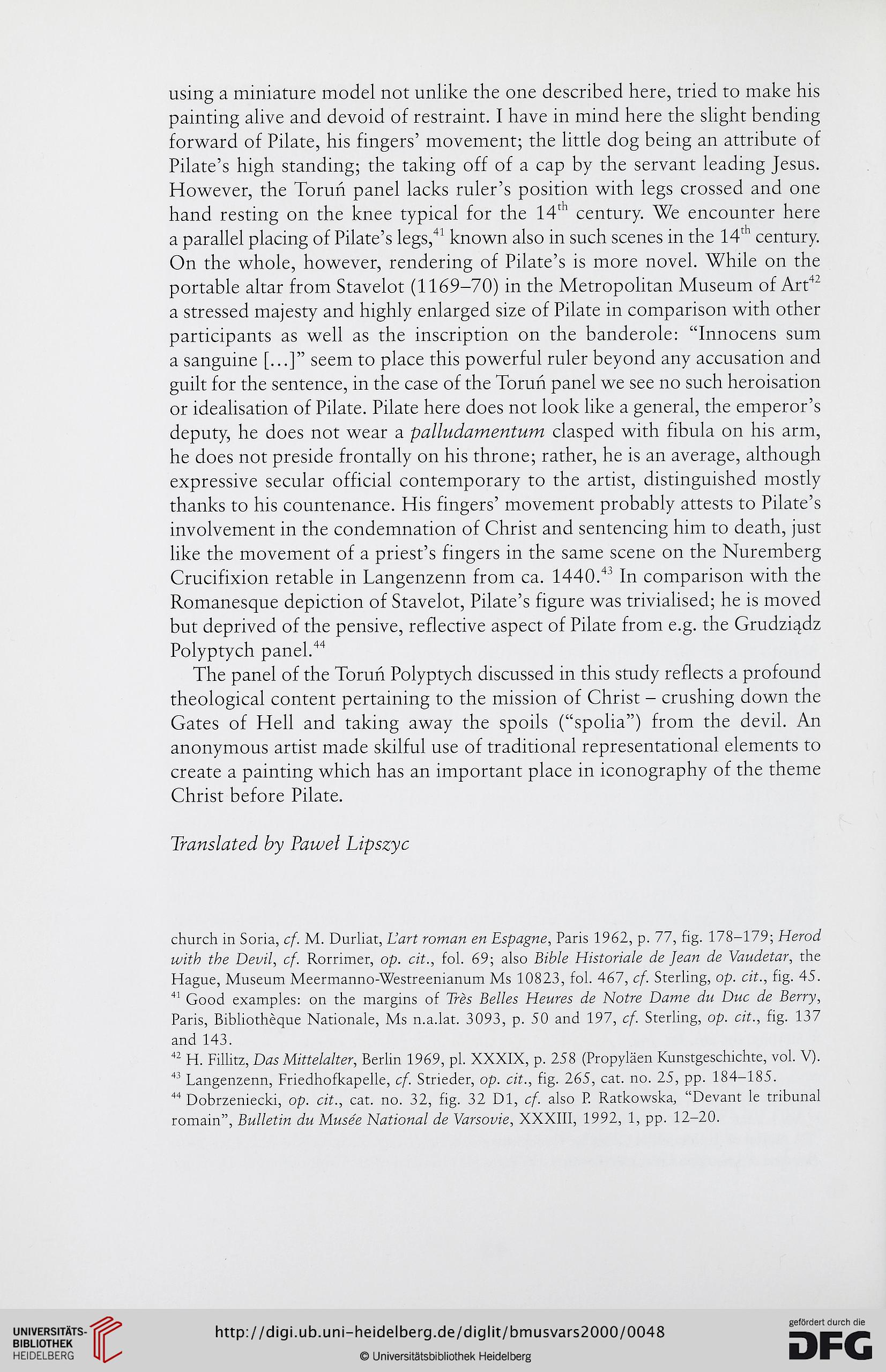using a miniaturę model not unlike the one described here, tried to make his
painting alive and devoid of restraint. I have in mind here the slight bending
forward of Pilate, his fingers’ movement; the little dog being an attribute of
Pilate’s high standing; the taking off of a cap by the servant leading Jesus.
However, the Toruń panel lacks ruler’s position with legs crossed and one
hand resting on the knee typical for the 14rh century. We encounter here
a parallel placing of Pilate’s legs,41 known also in such scenes in the 14th century.
On the whole, however, rendering of Pilate’s is morę novel. While on the
portable altar from Stavelot (1169-70) in the Metropolitan Museum of Art42
a stressed majesty and highly enlarged size of Pilate in comparison with other
participants as well as the inscription on the banderole: “Innocens sum
a sanguine [...]” seem to place this powerful ruler beyond any accusation and
guilt for the sentence, in the case of the Toruń panel we see no such heroisation
or idealisation of Pilate. Pilate here does not look like a generał, the emperor’s
deputy, he does not wear a palludamentum clasped with fibula on his arm,
he does not preside frontally on his throne; rather, he is an average, although
expressive secular official contemporary to the artist, distinguished mostly
thanks to his countenance. His fingers’ movement probably attests to Pilate’s
involvement in the condemnation of Christ and sentencing him to death, just
like the movement of a priest’s fingers in the same scene on the Nuremberg
Crucifixion retable in Langenzenn from ca. 1440.41 In comparison with the
Romanesąue depiction of Stavelot, Pilate’s figurę was trivialised; he is moved
but deprived of the pensive, reflective aspect of Pilate from e.g. the Grudziądz
Polyptych panel.44
The panel of the Toruń Polyptych discussed in this study reflects a profound
theological content pertaining to the mission of Christ - crushing down the
Gates of Heli and taking away the spoils (“spolia”) from the devil. An
anonymous artist madę skilful use of traditional representational elements to
create a painting which has an important place in iconography of the theme
Christ before Pilate.
Translated by Paweł Lipszyc
church in Soria, cf. M. Durliat, Hart roman en Espagne, Paris 1962, p. 77, fig. 178-179; Herod
with the Devil, cf. Rorrimer, op. cit., fol. 69; also Bibie Historiale de Jean de Vaudetar, the
Hague, Museum Meermanno-Westreenianum Ms 10823, fol. 467, cf. Sterling, op. cit., fig. 45.
41 Good examples: on the margins of Tres Belles Heures de Notre Damę du Duc de Berry,
Paris, Bibliotheąue Nationale, Ms n.a.lat. 3093, p. 50 and 197, cf. Sterling, op. cit., fig. 137
and 143.
42 H. Fillitz, Das Mittelalter, Berlin 1969, pl. XXXIX, p. 258 (Propylaen Kunstgeschichte, vol. V).
43 Langenzenn, Friedhofkapelle, cf. Strieder, op. cit., fig. 265, cat. no. 25, pp. 184-185.
44 Dobrzeniecki, op. cit., cat. no. 32, fig. 32 Dl, cf. also P. Ratkowska, “Devant le tribunal
romain”, Bulletin du Musee National de Varsovie, XXXIII, 1992, 1, pp. 12-20.
painting alive and devoid of restraint. I have in mind here the slight bending
forward of Pilate, his fingers’ movement; the little dog being an attribute of
Pilate’s high standing; the taking off of a cap by the servant leading Jesus.
However, the Toruń panel lacks ruler’s position with legs crossed and one
hand resting on the knee typical for the 14rh century. We encounter here
a parallel placing of Pilate’s legs,41 known also in such scenes in the 14th century.
On the whole, however, rendering of Pilate’s is morę novel. While on the
portable altar from Stavelot (1169-70) in the Metropolitan Museum of Art42
a stressed majesty and highly enlarged size of Pilate in comparison with other
participants as well as the inscription on the banderole: “Innocens sum
a sanguine [...]” seem to place this powerful ruler beyond any accusation and
guilt for the sentence, in the case of the Toruń panel we see no such heroisation
or idealisation of Pilate. Pilate here does not look like a generał, the emperor’s
deputy, he does not wear a palludamentum clasped with fibula on his arm,
he does not preside frontally on his throne; rather, he is an average, although
expressive secular official contemporary to the artist, distinguished mostly
thanks to his countenance. His fingers’ movement probably attests to Pilate’s
involvement in the condemnation of Christ and sentencing him to death, just
like the movement of a priest’s fingers in the same scene on the Nuremberg
Crucifixion retable in Langenzenn from ca. 1440.41 In comparison with the
Romanesąue depiction of Stavelot, Pilate’s figurę was trivialised; he is moved
but deprived of the pensive, reflective aspect of Pilate from e.g. the Grudziądz
Polyptych panel.44
The panel of the Toruń Polyptych discussed in this study reflects a profound
theological content pertaining to the mission of Christ - crushing down the
Gates of Heli and taking away the spoils (“spolia”) from the devil. An
anonymous artist madę skilful use of traditional representational elements to
create a painting which has an important place in iconography of the theme
Christ before Pilate.
Translated by Paweł Lipszyc
church in Soria, cf. M. Durliat, Hart roman en Espagne, Paris 1962, p. 77, fig. 178-179; Herod
with the Devil, cf. Rorrimer, op. cit., fol. 69; also Bibie Historiale de Jean de Vaudetar, the
Hague, Museum Meermanno-Westreenianum Ms 10823, fol. 467, cf. Sterling, op. cit., fig. 45.
41 Good examples: on the margins of Tres Belles Heures de Notre Damę du Duc de Berry,
Paris, Bibliotheąue Nationale, Ms n.a.lat. 3093, p. 50 and 197, cf. Sterling, op. cit., fig. 137
and 143.
42 H. Fillitz, Das Mittelalter, Berlin 1969, pl. XXXIX, p. 258 (Propylaen Kunstgeschichte, vol. V).
43 Langenzenn, Friedhofkapelle, cf. Strieder, op. cit., fig. 265, cat. no. 25, pp. 184-185.
44 Dobrzeniecki, op. cit., cat. no. 32, fig. 32 Dl, cf. also P. Ratkowska, “Devant le tribunal
romain”, Bulletin du Musee National de Varsovie, XXXIII, 1992, 1, pp. 12-20.




